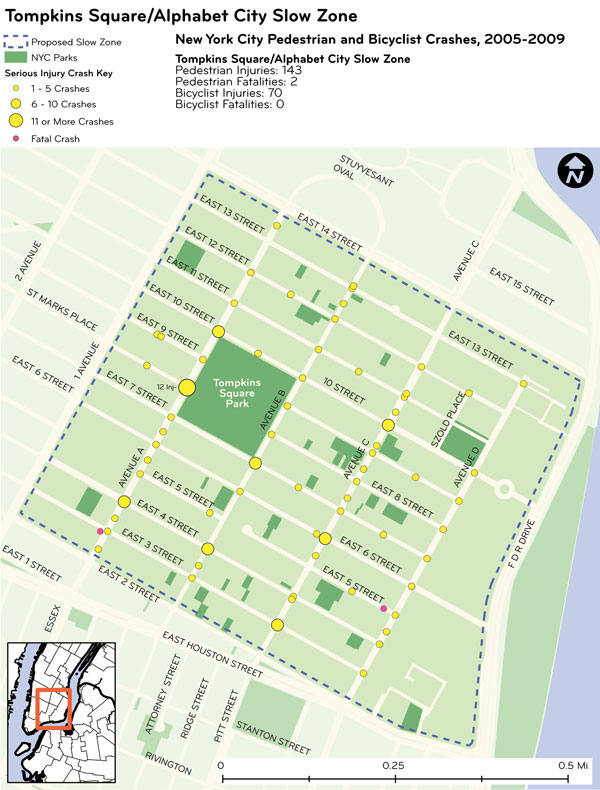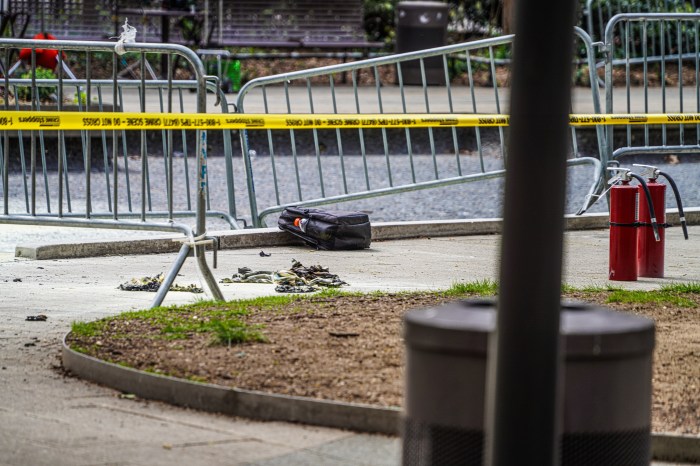
BY SERGEI KLEBNIKOV | Sammy Hagar sang, “I can’t drive 55!”
Well, now if the rocker ever drives through the East Village, he won’t even be allowed to drive 30.
Under a new “slow zone” initiative, the neighborhood’s speed limit is set to be shaved down to 20 miles per hour — 10 miles per hour below the city speed limit.
Construction for the new Tompkins Square / Alphabet City Slow Zone, approved by the Department of Transportation last October, started this month, and is set to be completed by next month.
Last year, D.O.T. renewed its slow zone program, which had been initiated under former Mayor Bloomberg. Mayor de Blasio supports the program, and it’s a component of his “Vision Zero” plan for eliminating street fatalities and injuries.
There were about 75 applications for local slow zones in the program’s second competitive application process, in 2013. Of the eight chosen for implementation, the Alphabet City-area slow zone is being rolled out first, said Chad Marlow, a Community Board 3 member who championed the original idea.
“It’s incredible that we got to go first,” he said.
Marlow completed and filed the application after noticing a statement from D.O.T. that the agency would be renewing the program. The application was submitted by the Tompkins Square Park & Playgrounds Parents’ Association, of which Marlow is a founder, and was subsequently endorsed by C.B. 3.
“It was something I absolutely had to do,” said Marlow, who explained how he was also motivated by his own experience.
When Marlow was 23 years old, his father was struck and nearly killed by a speeding drunk driver. The accident left his father with severe and lasting injuries, until he passed away 13 years later.
Understandably, the topic hits close to home for Marlow.
“I’ve always been extremely sensitive to the risk that speeding cars present for pedestrians,” he said.
D.O.T. looked at several factors in considering the applications. Nicole Garcia, a D.O.T. spokesperson, provided a presentation outlining the factors that made the East Village slow zone application so worthy of designation.
Statistically, the Alphabet City area is simply dangerous because of its traffic level and documented accidents.
It’s also a high-risk area: There are many schools, as well as parks, daycare and senior-care centers in the community.
Finally, incredible community support for the project helped move it forward, according to D.O.T. The idea of a zone in the East Village won strong backing from local officials, from the City Council to Congress, who represent the area.
Marlow firmly believes that the slow zone will help calm car traffic and reduce the number of accidents in the area each year.
“Any community that is eligible for a slow zone should want to have one,” he said. “There’s no downside.”
According to D.O.T., in New York City areas where neighborhood slow zones have been implemented, there has been a 10 to 15 percent decrease in speeds, a 14 percent reduction in crashes involving injuries and a 31 percent reduction in injuries caused by vehicles.
However, slow zones aren’t intended to slow things down so much that traffic doesn’t move.
According to D.O.T., “Slow zones are implemented in areas with low traffic volumes and minimal through traffic, where reducing the speed limit will not cause traffic congestion.”
The East Village slow zone will be larger than the average. It’s boundaries will be 14th St. on the north, the F.D.R. Drive on the east, Houston St. on the south and First Ave. on the west.
There will be new specialized “gateway” signs posted around the area’s boundaries, notifying drivers entering the zone of the reduced speed limit.
The slow zone will also include 20 new “speed humps” that will force drivers to slow down to 20 miles per hour. “Self-enforcing” mechanisms like these make the enforcement passive, as opposed to active, according to D.O.T. However, the level of active enforcement will be left up to the Police Department to determine, Garcia said.
Other additional elements will include high-visibility crosswalks and road markings.
Among other areas set to receive slow zones this year are Brownsville-East New York, Clinton Hill, Crown Heights, Jackson Heights and Sunnyside Gardens-Woodside.
The eight neighborhoods slated for slow zones in 2015 include the West Village, Brooklyn Heights, Prospect Heights and Astoria. Local parent and school advocates, led by Kelly Shannon, the principal of P.S. 41, are pushing for the West Village Neighborhood Slow Zone to be expanded to include a wider swath of the area, which would take in more schools.
Over all, Marlow said he is extremely “proud and pleased” at how the initiative is turning out. He had the idea for an East Village slow zone more than a year ago. That was followed by D.O.T.’s selection of the application, and then, in turn, a thorough planning process for the project.
Now Marlow’s vision for a safer neighborhood — a vision eagerly embraced by so many East Villagers — will at last become a reality.

















